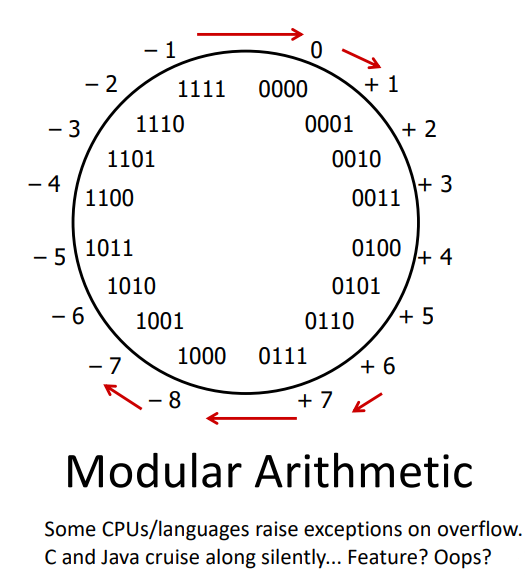CS 208 s21 — Integer Arithmetic
Table of Contents
1 Warmup
What base-10 integers do these 8-bit quantities represent using two's complement?
0b00001001= 90b10000001= -127
2 Two's Complement Arithmetic
- the same procedure works for both unsigned and two's complement addition
- add the bits as you would expect, discard any that carry out of the most significant bit
- example: \(4 + (-3)\) =
0100 + 1101=10001=0001= \(+1\)
- example: \(4 + (-3)\) =
- add the bits as you would expect, discard any that carry out of the most significant bit
- this is handy because it means the same hardware can perform both signed and unsigned addition
3 Overflow
- Overflow occurs when the result of a computation can't be represented by the current encoding
- For example, \(6 + 3\) =
0110 + 0011 = 1001= \(-7\)- The expected result of \(6+3=9\) exceeds the range of positive numbers 4-bit two's complement can represent
3.1 Fixed-width arithmetic is modular
When we have a fixed number of bits (e.g., 4-bit two's complement), arithmetic becomes modular.

The result of an addition is the sum modulo \(2^w\) (in raw binary—it's then up to the program whether the result is interpreted as signed or unsigned). Intuitively, think of fixed-width arithmetic as wrapping around when it goes too positive or too negative. With 4-bit two's complement, subtract 1 from -8 and it overflows to +7. Similarly, add 1 to +7 and it overflows to -8.
Here we finally see why int x = 200 * 300 * 400 * 500 results in a large negative value.
The result of the multiplication overflows the largest positive value than can be represented by a 32-bit int and wraps around into negative values.
4 Sign Extension
When converting signed integer to a larger integral type, extend with copies of the most significant bit (i.e., sign bit)
- 4-bits to 8-bits:
- 5 goes from
0101to00000101(still 5) - -5 goes from
1011to11111011(still -5)
- 5 goes from
- Called sign extension because we maintain the same value by extending the sign bit to fill in the new bits
- This is what C will do if you cast a smaller signed integer type to a larger one (i.e., cast an
intto along) - Casting unsigned types does not perform sign extension, the new bits are filled with zeros (zero extension).
- This is what C will do if you cast a smaller signed integer type to a larger one (i.e., cast an
5 Truncation
One the other hand, going from a larger integer type to a smaller one just throws away (truncates) the extra bits.
- 8-bits to 4-bits:
- 23 goes from
00010111to0111(now 7) - -23 goes from
11101001to1001(now -7)
- 23 goes from